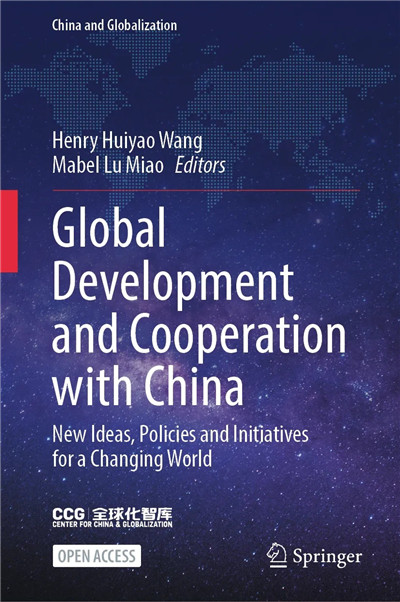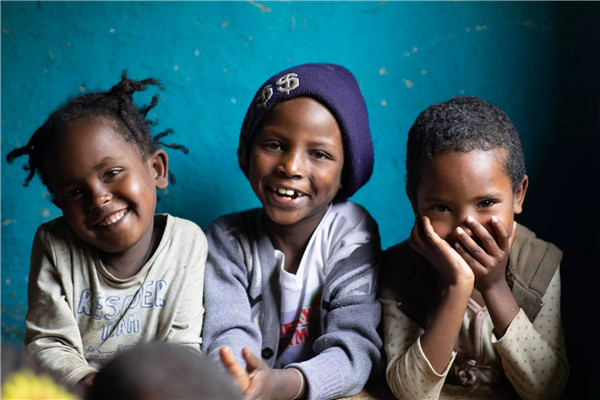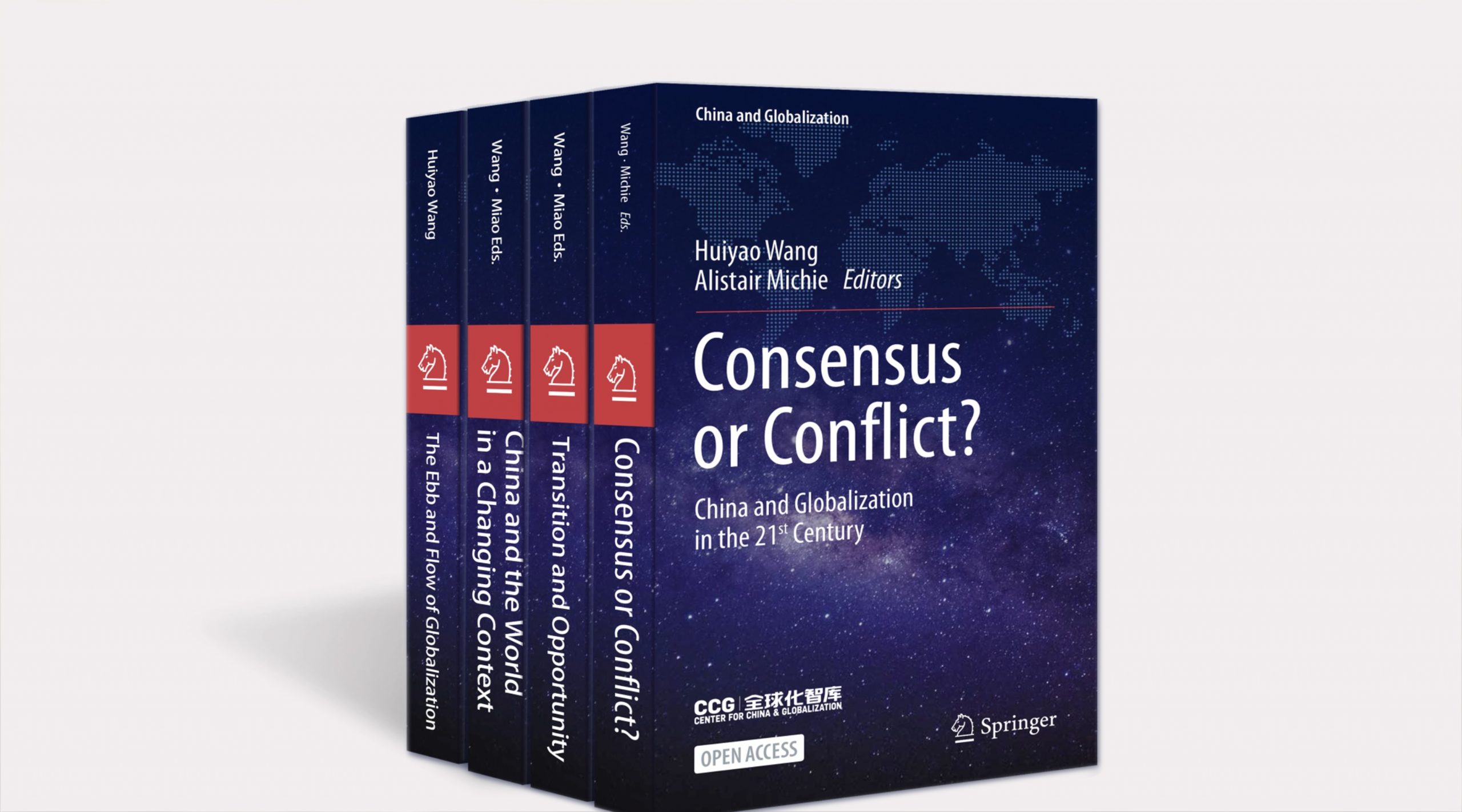Amakobe Sande: Progress for Children Is Progress for Everyone
Progress for Children Is Progress for Everyone: Keeping Children at the Front and Centre of International Development
By Amakobe Sande
UNICEF Representative to China
In a world simultaneously facing multiple crises, children face widening disparities in terms of health, education, nutrition, sanitation and a number of other areas, while millions of children miss out on essential vaccines and live in active conflict zones. UNICEF and China have been working together to reach some of the most vulnerable children in low-income and middle-income countries through South- South cooperation, but all countries have a responsibility to get progress for children back on track and achieve the SDGs. Promoting children’s rights and well-being is not separate from the development agenda; it is central to it.
The Situation for Children—progress Derailed
Children today are growing up in a world facing interdependent crises: the COVID-19 pandemic with its lost years of learning; conflicts that are becoming more intense and taking a heavier toll on civilians; the devastating impacts of climate change and higher costs of living. The damage is not affecting all girls and boys equally. The marginalized and vulnerable are affected the most and vast disparities in health (including mental health), education, nutrition, water and sanitation and protection services are widening.
Even before the pandemic, around 1 billion girls and boys worldwide—half of them in developing countries—suffered at least one severe deprivation, without minimum levels of access to education,health,housing,nutrition,sanitation or water, or social protection. The pandemic has made this worse. The percentage of children living in multidimensional poverty is estimated to have increased from 46 to 48% before COVID-19, to around 52% in 2021. This is equivalent to an estimated increase of 100 million additional children living in poverty compared to 2019.
In 2020, over 23 million children missed out on essential vaccines, an increase of nearly 4 million from 2019, and the highest number since 2009. Mental health conditions now affect more than 13% of adolescents aged 10–19 worldwide. Around 50 million children suffer from wasting—the most life-threatening form of malnutrition—and it is estimated that this number increased by 9 million by 2022 due to the pandemic’s impact on children’s diets, the nutrition services they can access, and feeding practices.
At the peak of pandemic-related school closures, more than 1.5 billion students were out of school. Millions of children are either not in school or not learning the basic skills they need to build a better future. Sustainable development goal 4— quality education for all—is off track almost everywhere in the world. Nearly six out of 10 children globally are estimated to be affected by learning poverty—meaning children who cannot read and comprehend a simple text at the age of 10 years old.
Pandemic-related lockdowns and school closures also made children across the world less safe,leading to higher rates of gender-based violence and violence against children. Services to prevent and respond to violence have been disrupted in 104 countries, where a total of 1.8 billion children live. While spending more time online, children have also been more exposed to inappropriate content and potential predators.
Globally, nearly one in five children—426 million—live in conflict zones, with conflicts becoming more intense and taking heavier tolls on civilians, and disproportionately affecting children. Women and girls are at the highest risk of conflict-related sexual violence. Around 80% of all humanitarian needs are driven by conflict. More children are displaced than ever before, with 82 million people worldwide forcibly displaced in 2022. The climate change crisis continues to make things worse, and nearly half of the world’s children—approximately 1 billion—live in countries that are at an ‘extremely high risk’ from the impacts of climate change.
These numbers reflect progress for children being knocked off course, with real consequences for the health, education and well-being of children and their families.
Towards Restoration—Mainstreaming Children in the International Development Cooperation Agenda
The need for international development cooperation is not just evident; it is urgent. It is estimated that even in a best-case scenario, it will take seven to eight years to recover and return to pre-COVID-19 rates of child poverty. All countries have a role to play in working together to achieve this recovery and getting the sustainable development goals back on track.
UNICEF is the United Nations’ global custodian for children in the Sustainable Development Agenda (and co-custodian with other UN agencies for a total of 18 global SDG indicators). The SDGs and child rights agenda reinforce each other. All the SDGs affect children, whether the goal relates to poverty (Goal 1), hunger (Goal 2), health (Goal 3), education (Goal 4), gender equality (Goal 5), climate change (Goal 13), violence against children (Goal 16.2) and in partnerships to address the SDGs (goal 17). More than 100 Member States have renewed their commitment to children’s rights in the context of implementing the SDGs. An approach to implementing the SDGs that puts children’s rights and well-being at the front and centre is not only imperative, it can also catalyse sustainable development by breaking down the transfer of poverty and exclusion from one generation to the next.
Investment in children, including those left behind, has strong spillover effects. Child development and well-being are cross-cutting and encompass several fields, including health, nutrition, water, sanitation and hygiene, child protection and social protection. Studies show that cross-sectoral improvements in these areas can contribute to alleviating multidimensional poverty and promote economic growth. For example, investing in compulsory education can contribute to improved results in nutrition, water safety and child protection.
This is an ambitious agenda. But by working together and ensuring that investments from international development cooperation from China and other countries reach children, we can contribute to the achievement of the SDGs with children at the centre.
The China-UNICEF Partnership
UNICEF works globally with governments and other partners to promote and uphold the rights of children, in line with the Convention on the Rights of the Child. UNICEF and the Government of the People’s Republic of China have nearly 44 years of partnership in China, and China ratified the Convention on the Rights of the Child in 1992.
In addition to implementing eight successive country programmes of cooperation within the country, UNICEF and the Government of China have been working together to reach some of the most vulnerable children in low-income and middle- income countries through South-South cooperation. This collaboration dates back to 2010 when China hosted the initiative that birthed the Beijing Declaration on South-South Cooperation for Child Rights in the Asia Pacific Region (2010) with 28 countries, which focussed on (i) disaster risk reduction; (ii) child protection and welfare systems; and (iii) ensuring that economic and social development is equitable and reaches all children.
China, in cooperation with UNICEF, has been providing support through its Global Development and South-South Cooperation Fund (GDF)—previously the South-South Cooperation Assistance Fund (SSCAF). In 2020 and 2021, UNICEF worked with governments and a range of partners in African countries to implement projects funded by China. Projects ranged from expanding maternal, newborn and young child health and nutrition services, to supporting vulnerable families in recovering from the shocks of Cyclone Idai, the COVID-19 pandemic and a desert locust infestation.
UNICEF also received support from the Ministry of Commerce (MOFCOM) for projects in Myanmar, Cambodia, Ethiopia and Lao PDR in areas of early child-hood development, oxygen for the COVID-19 response, and scaling up treatment for children with severe acute malnutrition.
Working with UNICEF, China has helped to ensure that some of Africa’s and Asia’s most vulnerable children get a fairer start in life. With support from China, and in partnership with national and local authorities, UNICEF offices were able to renovate and revitalize hospitals, maternity wards and special infant care clinics, inline with best practices. UNICEF brought new medical equipment, essential medicines and therapeutic foods to remote facilities, with many facilities receiving such items for the first time. Technical teams also supported doctors, nurses, healthcare workers and community volunteers in raising their skills, capacities and motivation to keep children alive, healthy and thriving.
Based on the mutually reinforcing nature of progress towards the SDGs and upholding child rights, there is a wide array of opportunities to contribute through continued partnership, building on the experiences that the Government of China and UNICEF have shared in international development through South-South cooperation.
Below are areas where China’s international development cooperation could have an effective and positive impact on children, their rights and their well-being. These also represent opportunities for both partnering with UNICEF and other relevant multilateral organizations, and engaging children and young people in the issues that affect them in the world today.
Maternal, Newborn and Child Health
Outbreaks of infectious diseases are becoming more commonplace and more intense. Modern life, with widespread global travel, humans’ deeper penetration into animal habitats, political instability and conflict, migration and accelerating climate change, is encouraging the more rapid spread of infectious diseases. A reduction in routine child immunization has only exacerbated these trends. Coverage of life-saving routine immunizations for children dropped sharply amid COVID-related disruptions and strains on health systems. Global coverage of routine immunization slid from 86% in 2019 to 81% in 2021. In the wake of these declines, 2022 saw large outbreaks of measles, and the World Health Organization has warned that the disease is now an ‘imminent threat’ in every part of the world. Reversing these trends will require ensuring every child receives life-saving vaccines, including children in the most marginalized communities.
We need comprehensive action to both restore vaccination services and prepare for new outbreaks. To achieve the Global Immunization Agenda 2030, WHO, UNICEF and GAVI are calling for: restoring services and vaccination campaigns, helping health workers and community leaders communicate with caregivers to explain the importance of vaccinations; rectifying gaps in immunization coverage, including identifying communities and people who missed vaccinations during the pandemic; ensuring continuous supply of affordable vaccines to meet global needs, and applying lessons from COVID-19 to other diseases.
China has experience in implementing a system for the Expanded Program on Immunization (EPI), providing vaccinations that protect against 15 diseases. Building on over 40 years of progress in the EPI, including experiences from COVID-19 vaccination, China can play an important role in partnership with the relevant international entities by providing countries in need with technical support, experience sharing, and expertise, to help implement global actions effectively and restore routine immunization for children.
Further, the Government of China and UNICEF have seen success in co-operating to mitigate some of the impacts of COVID-19. When the first cases of COVID-19 were detected in Africa, the Government of China provided resources from its Global Development Fund (GDF) through UNICEF in support of four African partner countries in need of an urgent humanitarian response. The resources were focussed on restoring access to basic health and nutrition services that keep children alive and growing. The project, implemented in Cameroon, Ghana, Liberia and Senegal, reached over 2.7 million people—including highly vulnerable mothers, infants and young children—with enhanced health and nutrition services.
Nutrition
Children’s diets are unacceptably poor. Despite the importance of good nutrition across the life cycle, globally, at all ages, millions of children and adolescents are not benefiting from diets that support healthy growth and development. This is a complicated issue—globalization, urbanization, inequities, environmental crises, health epidemics and humanitarian emergencies are just some of the critical challenges to feeding children sustainably, today and for generations to come. In the context of the ongoing global food and nutrition crisis, UNICEF is also drawing urgent attention to a global nutrition crisis in adolescent girls and women of reproductive age (15– 49 years) which focuses on undernutrition, micronutrient deficiencies and anaemia and the barriers they face in accessing nutrition services and benefiting from positive nutrition and care practices. No region in the world is on track to meet the 2030 global targets to reduce anaemia and low birthweight, and acute malnutrition has risen by 25% since 2020 in crisis hit countries.
To mainstream children’s rights to nutrition, we need a new global response. This response must deliver diets, services and practices that promote breastfeeding and good nutrition at every stage of life and create a healthy food environment for all. The food system plays a central role, and the nutrition sector needs to work together with health, water and sanitation, education, and social protection systems, to provide nutritious, safe, affordable and sustainable diets for children.
Reducing malnutrition among children under 5 years old is a cost-effective investment in global development. Research has proven that early-life nutrition interventions, such as exclusive breastfeeding and micronutrients supplementation, can contribute to lifelong health. China’s experience with the ‘Ying Yang Bao’ (YYB) is a helpful case study. YYB is a protein-rich, soy-based fortified complementary food supplement scientifically developed in China that contains vital vitamins and minerals needed for healthy development, such as iron, zinc, calcium, vitamin B2 and vitamin D. Research indicates that YYB consumption among infants and young children notably decreased anaemia and stunting.
The national YYB programme provides a case study for other countries to learn from. UNICEF in China supported the development of YYB products and an operational piloting study for the programme. UNICEF also helped setup the monitoring and evaluation system of the national YYB programme.
China and UNICEF also have a track record of collaborating successfully in the field of food security. Following a crop-destroying desert locust invasion that caused widespread damage in the Democratic Republic of the Congo and South Sudan in 2020, the Government of China, UNICEF and national partners provided nutrition supplies to treat over 30,000 children. The programme also improved the capacity of 2224 health workers to detect severe acute malnutrition (SAM), and it provided counsel to over 130,000 caregivers and mothers in how to provide better nutrition for their children. The capacity of government partners to monitor, report and provide timely inputs to their nutrition programmes was also enhanced.
Water, Sanitation and Hygiene
Every child has the right to safe and equitable water, sanitation and hygiene (WASH) services and the right to live in a safe and clean environment. However, today 1.42 billion people—including 450 million children—live in areas of high or extremely high water vulnerability. Over 700 children under 5 years of age die every day of diarrhoeal diseases due to a lack of appropriate WASH services. Some 2.3 billion people worldwide, including hundreds of millions of school-going children, still do not have access to handwashing facilities with soap and water. Children living in rural areas, urban slums, disaster-prone areas and low-income countries are the most vulnerable and the most affected.
To address these challenges, UNICEF has set an ambitious goal to reach 450 million children and their families (1.42 billion people) living in areas of high or extremely high water vulnerability with resilient solutions by 2025. And by 2030, for all children to have access to safe and affordable water and sanitation. Such efforts include ensuring more sustained and resourced WASH access and systems, and empowering communities with gender-equal, inclusive, affordable and sustainable services to meet the rights of all children.
But this cannot be accomplished alone. Achieving SDG 6 for children requires international cooperation to galvanize all of society, from all sectors and a wide range of partners to enable policy commitments and changes, increased financing, enhanced capacity and innovations, including those coming from young people as champions and agents of change.
China’s expertise, experience, practices and technologies in the water and sanitation sector can be leveraged to support SDG 6 with UNICEF and other partners for children globally through international cooperation. China’s experience and solutions range from the nation-wide Rural Drinking Water Safety Project and the Rural Toilet Revolution, to affordable and sustainable technology solutions such as solar-powered water supply systems, circular treatment and utilization of wastewater and sanitary resources in agriculture and bioenergy, and others.
Education and Digital Learning
The world is facing an unprecedented learning crisis – SDG 4 is off track almost everywhere in the world. According to a World Bank, UNICEF and UNESCO report, nearly six out of 10 children globally are estimated to be affected by learning poverty, meaning 60% of children globally cannot read a simple text with comprehension by the age of 10. The situation is even worse in low-income and lower-middle-income countries.
Connectivity and information technology can be powerful enablers and tools for transforming the way teaching and learning take place. But there are still more than 1.3 billion children between the age of 3–17 who do not have access to the internet in this increasingly connected world. The COVID-19 pandemic has highlighted the urgency of making educational technologies accessible for everyone. In today’s job market, technology and digital literacy are essential skills. Children, especially girls, who do not have access to digital education will not be able to acquire all the abilities they need to enter the labour market.
To harness the power of digital learning to close educational divides, policies, actions and investments must be recalibrated to target those most in need of opportunities. We must invest more in bridging the digital divide and advancing world-class digital learning solutions.
Globally, in September 2022, UNICEF and its partners launched the Gateway Initiative, a global initiative to support children and youth anywhere in the world, including the most vulnerable, to have equal access to quality digital learning platforms and content to equip them with digital skills.
China has been advancing digital education and using technologies to support learning and skills development. China has taken the initiative to build the World Digital Education Alliance to join forces and advance digital education worldwide. There are opportunities for China and UNICEF to transform digital learning for children, and benefit more children in China and beyond.
Climate Change and the Environment
Climate change is increasing the risk of natural disasters and impacting health and socio-economic gains made over recent decades. In China, the impacts of climate change are evident, with extreme weather events affecting the health and socio- economic well-being of its citizens. According to the Intergovernmental Panel on Climate Change (IPCC), China’s economic losses are expected to worsen as floods are becoming more frequent and sea levels rise, threatening coastal cities. Decreases in crop yields, further loss of biodiversity and worsened water scarcity are also expected along with rising mortality and morbidity.
Children are the most vulnerable to climate change. For example, they are more likely to be affected by undernutrition and vector-borne and diarrhoeal diseases. The physical dangers of extreme weather—flooding, heatwaves, mould growth in homes and schools, building collapse and pollution—also pose serious threats to children. Children in the global South and countries situated in the lower latitudes are highly vulnerable because they have the fewest resources to adapt to climate change.
Recognizing the importance of climate change, China has promised to achieve peak carbon dioxide emissions by 2030 and carbon neutralization by 2060. Moreover, China continues to address reducing human exposure to environmental hazards through investment in environmental public health tracking and regulation. UNICEF is currently working with China to further environmental health.
To mainstream children in climate change and green development, we need stronger support for countries in the global South for their adaptation and mitigation efforts. China has renewable energy capacities, and it continues to improve its green technology and expertise. It is well positioned to not only advance its own carbon and adaption goals, but also in partnership with the UN share experiences, technology and resources with other countries in the global South.
Child Protection in the Digital World
UNICEF envisions a world where child survival, growth, development and well- being are improved through digitally enabled health and nutrition delivery systems, and where digital technologies and innovations are applied to solve a wide range of additional development challenges, such as the previously mentioned education divide. Digital applications can be used to improve information and counselling on maternal and child health, nutrition, child protection and social services for children and families. Digital solutions can enhance women’s and girls’ access and engagement, and they can provide greater access to children with disabilities, to equitable participation in society, and reducing some of the barriers they face.
Yet, fragmentation of the internet can exacerbate free and equal access to the internet for information and learning. And digital technologies also come with risks for children and young people, such as inappropriate or harmful content, online abuse and bullying, and over-use.
We need to ensure that girls and boys of all abilities, and backgrounds have equitable access to the digital solutions that can help them learn and develop. Regulations and safeguards are needed to protect children online. And, both governments and the private sector have a role to play.
China has the potential to support the development and use of technology for children’s well-being. As this technology develops, we need together to champion regulations and standards that respect child rights and promote children’s safety. At the same time, AI and other technologies, that can indeed contribute to children’s well-being, should adopt rigorous age-appropriate design tools, that ensure safety and protection.
Addressing Multi-dimensional Child Deprivations
Addressing multidimensional child deprivations is an urgent task for both developed and developing countries. Globally, the climate crisis, increased conflict and the COVID-19 pandemic have significantly affected the well-being of children and their families.
If unaddressed, poverty and deprivations can persist from one generation to the next, creating an intergenerational cycle of poverty. Actions to address multidimensional child deprivations require a multi-sectoral approach. The children who are the most excluded and their families need to be prioritized.
Tackling multidimensional child deprivations also requires universal social protection systems, improved access to high-quality public services, better monitoring and reporting, as well as family-friendly policies and inclusion of measures to reduce multidimensional child deprivations in national budgets, policies and laws.
UNICEF supports governments to measure, monitor and report on multidimensional child deprivations to help understand which children are in poverty and to facilitate action and tracking progress. UNICEF also works with governments in identifying, designing and implementing policies, programmes and financing strategies. There is an opportunity to include this area and incorporate these steps within international development cooperation efforts.
Conclusion
All countries have a responsibility to get progress for children back on track and achieve the SDGs. Promoting children’s rights and well-being is not separate from the development agenda; it is central to it. Supporting the world’s children is critical as we collectively mitigate the effects of confict, climate change and new and existing infectious diseases.
International development cooperation offers a wide range of opportunities for putting children at the centre. Child development is a cross-cutting discipline that encompasses different fields, including health, education, nutrition, water, sanitation and hygiene, climate change and environment, child protection and social policy. Improvement in these areas is urgent for children and can help combat poverty and promote economic growth.
We need investment, and we need action—now, not tomorrow. UNICEF is calling for development resources to be mobilized from a broader range of stakeholders, including international financial institutions, the private sector, non-profit foundations and trilateral cooperation with other donor countries to amplify the results. Further, governments need to continuously improve their ability to allocate resources to development. Opportunities for the mobilization of resources, and improvements for the efficiency of resource allocation can be found through partnerships. Partnerships can use the strengths of different types of organizations and stakeholders and can build momentum to achieve results that individual stakeholders cannot reach alone.

Amakobe Sande is currently the UNICEF Representative to China and has 30 years of experience and expertise in international development, humanitarian coordination, policy analysis, advocacy, resource mobilization and partnership. Prior to joining UNICEF, she was the Resident and Humanitarian Coordinator in Eritrea and led UNAIDS as Country Director in Beijing, as well as in Uganda, Malawi and Lesotho. Prior to joining the UN, she worked in renowned international organisations such as Oxfam and Action Aid International throughout Africa, Middle East and Western Asia. Ms. Sande received a Master’s degree in Development Studies from the Australian National University in Canberra, Australia and a Bachelor’s Degree in International Relations from the United States International University in Nairobi, Kenya.
Editor’s Note
This essay is selected from the book Global Development and Cooperation with China: New Ideas, Policies and Initiatives for a Changing World, which is the ninth volume of the “China and Globalization Series” books. This book series seek to create a balanced global perspective by gathering the views of highly influential policy scholars, practitioners, and opinion leaders from China and around the world. The open access book Global Development and Cooperation with China combines the insights and wisdom of 26 representatives from a wide range of international organizations into a collection of 21 essays, focusing on the latest trends in four major areas—global governance, trade and economics, science and technology, and culture and exchange—providing the reader with information on the latest developments in these areas with a special focus on China and its relevant contributions.

Editors: Henry Huiyao Wang, Mabel Lu Miao
ISBN: 978-981-96-2452-2
Published in April, 2025
Publisher: Springer Nature
Download at Springer Nature:
https://link.springer.com/book/9789819624515





